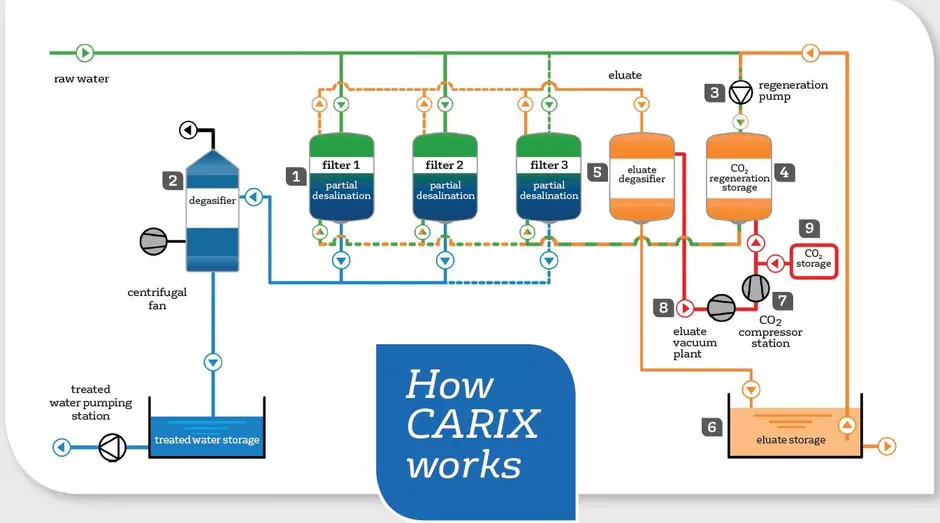Carix™ is the only ion exchange process for drinking water softening without harmful regeneration chemicals. The exchanger resins are regenerated by the produced carbon dioxide.
Overview
Benefits
- low operating costs through the environmentally-friendly regeneration of both exchange resins by only one regeneration medium and its recovery
- ca. 60% less wastewater and ca. 50% less energy consumption compared to membrane desalination (nanofiltration, reverse osmosis)
- simultaneous removal of cations and anions without corrosive effects on the water quality
- direct wastewater discharge of solids-free "mineral water" to the receiving stream without adding salt by means of regeneration chemicals or antiscalants
- trouble-free operation in the partial load range or during system startup and shutdown
- easy to use with maximum process automation
- stable and insensitive to changes in the quality of untreated water
- environmentally friendly consumption of greenhouse gas carbon dioxide during regeneration
- consumers save energy and use less detergents, washing and cleaning agents
- protection of equipment against failure due to scaling or fouling and corrosion
Proven to work
To date more than fifteen Carix™-plants have been installed all over Germany.
The first plant started in 1986 and since then has delivered top-quality drinking water.
Applications
Hard water
Wherever there is hard water, there is limescale caused by calcium, magnesium and hydrogen carbonate dissolved in the water. Increased concentrations of sulfate and chloride can also have a corrosive effect on concrete and metal, whereas nitrates in higher quantities are harmful to one's health. That is why many households and businesses frequently rely on decentralized water softening units, which must be regenerated with the aid of environmentally harmful chemicals such as acid, lye or saline solutions.
Economic softening
The Carix™ ion exchange process (CArbon Dioxide Regenerated Ion EXchanger) allows for a purposeful partial desalination and therefore softening of drinking water containing high amounts of hardeners, nitrate and sulfate.
For regenerating the ion exchange filter the resulting carbon dioxide (CO2) is used instead of chemicals, which otherwise would be released into the atmosphere.
Thanks to this type of regeneration, the waste water contains the right ratio of substances that were absorbed during the softening process. The wastewater is a carbonated "mineral water" of drinking water quality that is free of solids.
Contrary to other desalination technologies, Carix™ does not result in an increased salinity in the wastewater due to regeneration chemicals as occurs with conventional ion exchangers or the addition of phosphates when using antiscalants with membrane desalination (nanofiltration, reverse osmosis).
The environmentally friendly Carix™ process

- 1 - The untreated water flows through the ion exchange filter (1) from top to bottom. In this stage the actual partial desalination takes place.
- 2 - This step reduces calcium, magnesium, carbonate hardness, sulfate, nitrate and chloride, where CO2 forms as reaction product, which is removed from the water in the downstream degasifier (2).
- 3 - During regeneration the exchanger resins are regenerated by removing the ions and replacing them with H+ and HCO3- ions accumulated from the regeneration solutions (CO2) in the water. The untreated water is pumped by means of a regeneration pump (3) to the regeneration storage tank (4) and enriched with CO2 from the recovery process (8) and if necessary from a CO2 tank (9).
- 4 - The regeneration solution (CO2-enriched water) flows from the regeneration storage tank (4) to the exchanger filter.
- 5 - In the eluate degasifier (5), approx. 95% of the CO2 is recovered from the regeneration stream and pumped back to the regeneration storage tank (7).
- 6 - The eluate, which is the wastewater from the regeneration process, flows from the regenerated filter via the eluate degasifier (5) to a storage tank (6). Approx. 40% of the eluate is re-used for the next regeneration cycle.


